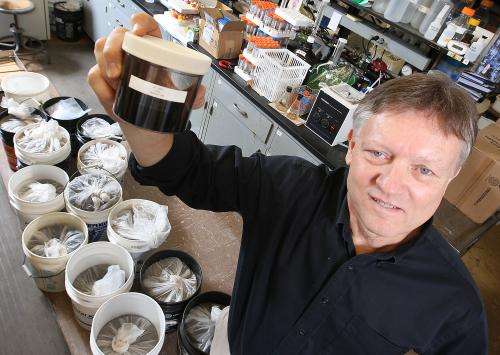Some carbon nanotubes deplete beneficial microbes in certain soils

(Phys.org)—Some types of carbon nanotubes used for strengthening plastics and other materials may have an adverse effect on soil microbiology and soil microbial processes, a Purdue University study shows.
Specifically, these raw, non-functionalized single-walled carbon nanotubes were shown to damage the active microbiology in low-organic soil. Ron Turco, a professor of agronomy, said many of the bacteria affected could be involved in carbon and nitrogen cycling, which are critical processes to ensure a fully functional soil.
"There appears to be more negative potential on the active microbial population than we thought," said Turco, whose findings were published in the journal Environmental Science & Technology. "The as-produced materials could be a negative environmental situation if they are released into low-organic soils that could not absorb them."
Functionalized carbon nanotubes have modifications that create chemical or biological changes to the nanotubes. They're often used in medicines, and Turco's research showed they had no effect in high-organic or low-organic soils.
Non-functionalized single-walled nanotubes - those lacking intentional surface alterations - are being added to a variety of products during manufacturing because they can strengthen the material without adding much weight. Nanotubes contained in manufacturing waste products may find their way into wastewater treatment plants and bio-solids that result from water purification. Those bio-solids cannot be released into water, so they are often discarded by spreading on land, adding critically needed plant nutrients to soil.
"Land application of biosolids is standard procedure now," Turco said. "If any of that contains nanotubes, that could be a problem."
Single-walled nanotubes also didn't affect microbes in high-organic soils, Turco said, likely because organic materials are highly reactive. Organic materials may have reacted with the nanotubes, leaving them unable to affect microbes.
"We want to alert people to the fact that if you're going to apply these as part of a land-treatment program, you may want to focus on high-organic matter soils," he said.
It's also possible, though much less likely, that nanotubes could contaminate soil through accidental spills during a delivery, Turco said.
Next, Turco said he would look at the effects on plants and soils from other nanomaterials and nanometals that are being more widely used in products for different properties they convey, such as nanosilver for its disinfecting properties and nanoindium, which is used in electronics.
More information: Response of Soil Microorganisms to As-Produced and Functionalized Single-Wall Carbon Nanotubes (SWNTs), Zhonghua Tong, Marianne Bischoff, Loring F. Nies, Phillip Myer, Bruce Applegate, and Ronald F. Turco, Environmental Science & Technology, 2013.
Abstract
The use of single-wall carbon nanotubes (SWNTs) in manufacturing and biomedical applications is increasing at a rapid rate; however, data on the effects of a potential environmental release of the materials remain sparse. In this study, soils with either low or high organic matter contents as well as pure cultures of E. coli are challenged with either raw as-produced SWNTs (AP-SWNTs) or SWNTs functionalized with either polyethyleneglycol (PEG-SWNTs) or m-polyaminobenzene sulfonic acid (PABS-SWNTs). To mimic chronic exposure, the soil systems were challenged weekly for six weeks; microbial activities and community structures for both the prokaryote and eukaryote community were evaluated. Results show that repeated applications of AP-SWNTs can affect microbial community structures and induce minor changes in soil metabolic activity in the low organic matter systems. Toxicity of the three types of SWNTs was also assessed in liquid cultures using a bioluminescent E. coli-O157:H7 strain. Although decreases in light were detected in all treated samples, low light recovery following glucose addition in AP-SWNTs treatment and light absorption property of SWNTs particles suggest that AP-SWNTs suppressed metabolic activity of the E. coli, whereas the two functionalized SWNTs are less toxic. The metals released from the raw forms of SWNTs would not play a role in the effects seen in soil or the pure culture. We suggest that sorption to soil organic matter plays a controlling role in the soil microbiological responses to these nanomaterials.
Journal information: Environmental Science & Technology
Provided by Purdue University















